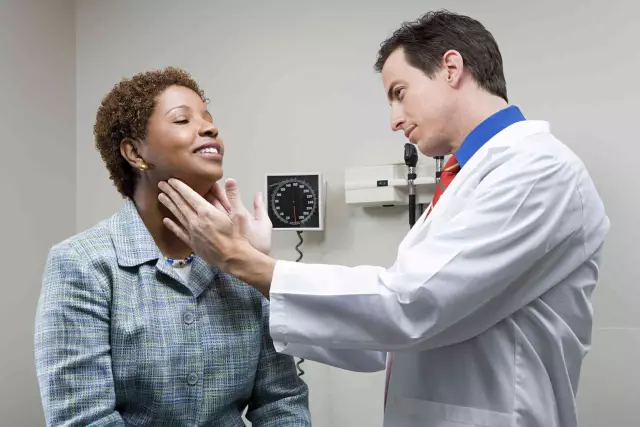- Author Rachel Wainwright [email protected].
- Public 2023-12-15 07:39.
- Last modified 2025-11-02 20:14.
Arachnodactyly
The content of the article:
- Causes
- Signs
- Diagnostics
- Treatment
- Prevention
Arachnodactyly (literally "spider fingers") is a deformation of the fingers of the hand, observed in some hereditary pathologies. As a rule, arachnodactyly is accompanied by the elongation of the tubular bones (which leads to skeletal deformities), pathological changes in the cardiovascular system and eyeballs.

The main external sign of arachnodactyly is thin and long fingers
Causes
Arachnodactyly occurs due to genetic abnormalities. It is most commonly seen in patients with homocystinuria or Marfan syndrome. In addition, there is a wide group of hereditary pathologies called Marfan-like syndromes (for example, lens ectopia syndrome or aortic dilatation and dissection syndrome), which are characterized by arachnodactyly, but at the same time, internal organ damage has certain differences from the pathologies observed in Marfan syndrome.
Signs
The main external sign of arachnodactyly is thin and long fingers, which, due to shortened tendons, acquire a characteristic curvature, which gives them the appearance of a spider's paw.
Changes in the structure of the fingers of the hand are clearly visible from the first days of a child's life, however, the characteristic appearance of the limb is formed by about 3-4 years.
With arachnodactyly, the growth of newborns is usually much higher than average. The lower legs and forearms are also elongated, which makes them appear disproportionately developed and thin. Body imbalance is exacerbated by too high kneecaps and waist.
As a rule, other disorders of the skeletal structure are observed:
- a narrow and long skull (dolichocephalic) with an altered facial part;
- "Bird" or funnel-shaped structure of the chest;
- curvature of the spine;
- congenital dislocation of the hip;
- habitual dislocation of the shoulder and / or knee;
- deformation of the calcaneus;
- the formation of osteophytes - pathological growths on bone tissue;
- flat feet;
- poorly developed fat layer.
Arachnodactyly in Marfan syndrome is also accompanied by the following deviations:
- myopia;
- bluish tint to the sclera;
- subluxation of the lens;
- damage to the valvular apparatus of the heart;
- aortic aneurysm;
- underweight;
- pathological joint mobility;
- arched sky.
In addition, with Marfan syndrome, pyramidal disorders, asymmetry of tendon reflexes, nystagmus and anisocoria are possible. Intellect is saved.

Arachnodactyly and other signs in Marfan syndrome
Arachnodactyly against the background of homocystinuria is accompanied by:
- convulsive seizures;
- subluxation of the lens;
- secondary glaucoma;
- retinal detachment;
- astigmatism;
- damage to the coronary, cerebral and renal arteries;
- gothic sky;
- osteoporosis;
- arterial thrombosis;
- decreased intelligence.
Diagnostics
Diagnosis of the disease that caused arachnodactyly is carried out on the basis of external examination data, study of the patient's family history and the results of laboratory and instrumental studies. The survey includes:
- X-ray of the chest, spine and pelvis;
- scintigraphy;
- computed tomography of bones and joints;
- Ultrasound of the heart and arterial vessels;
- magnetic resonance imaging of the brain and internal organs;
- rheoencephalography;
- electroencephalography;
- biochemical analysis of blood and urine.
Patients with arachnodactyly should definitely be consulted by a geneticist, cardiologist, ophthalmologist, neuropathologist and orthopedist.
Treatment
There is no specific treatment for arachnodactyly; symptomatic therapy is performed. With Marfan syndrome, in order to improve metabolism, patients are prescribed anabolic steroids and ascorbic acid in high doses.
With homocystinuria, patients must follow a special diet with a minimum of animal protein for life. They are also recommended micro-doses of acetylsalicylic acid and large doses of B vitamins.

For arachnodactyly due to homocystinuria, a lifelong protein-free diet is indicated
As a supportive therapy, spa treatment provides good results.
If life-threatening complications develop, they are surgically corrected (for example, prosthetics of the aorta or heart valves).
Prevention
Arachnodactyly is a symptom accompanying hereditary pathology, therefore, there are no measures to prevent it. If there are cases of homocystinuria, Marfan syndrome or Marfan-like diseases in the family, spouses are advised to consult with a geneticist at the stage of pregnancy planning to determine the likelihood of having a sick child.

Elena Minkina Doctor anesthesiologist-resuscitator About the author
Education: graduated from the Tashkent State Medical Institute, specializing in general medicine in 1991. Repeatedly passed refresher courses.
Work experience: anesthesiologist-resuscitator of the city maternity complex, resuscitator of the hemodialysis department.
The information is generalized and provided for informational purposes only. At the first sign of illness, see your doctor. Self-medication is hazardous to health!






